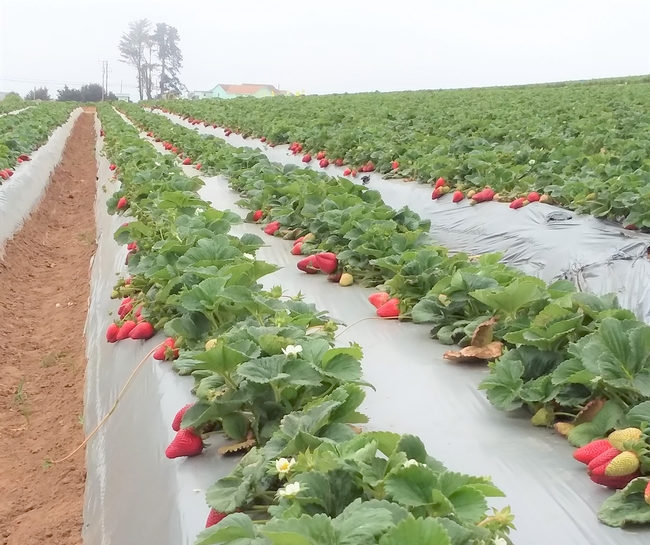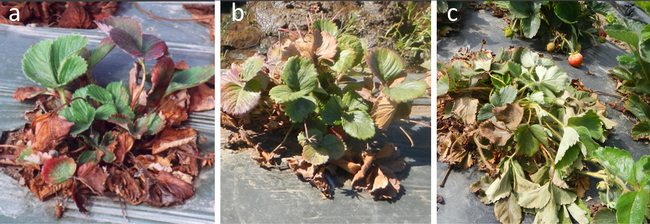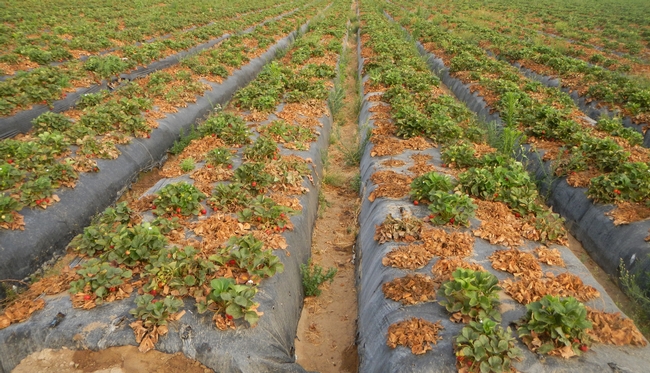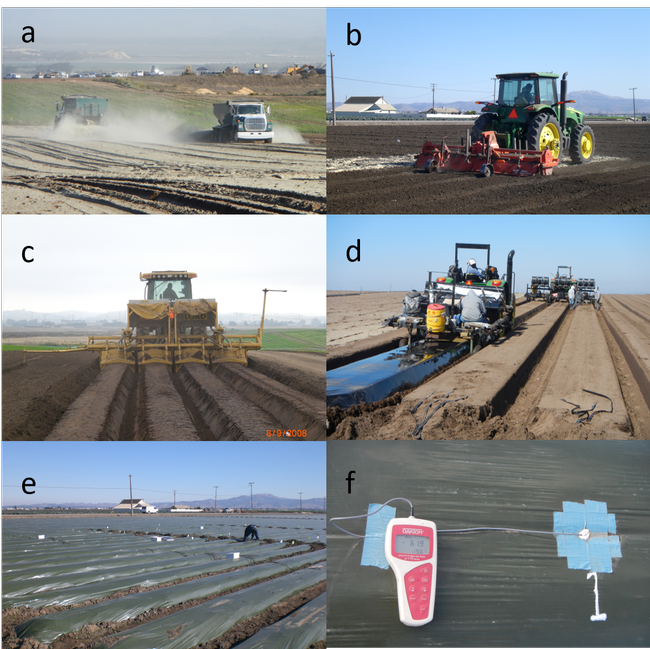Posts Tagged: Integrated Pest Management
UC explores alternatives to fumigants for strawberries
Strawberries, which generated $2.2 billion for California growers mainly on the coast in 2019, are sensitive to soilborne diseases. Strawberry plant roots infected by fungi are unable to take in nutrients and water, causing the leaves and stems to wilt. The diseases reduce fruit yields and eventually kill infected plants.
To protect the delicate plants from pathogens, strawberry growers fumigate the soil with pesticides such as chloropicrin and 1,3-dichloropropene before planting transplants. Due to the potential negative effects on the environment and human health, however, use of fumigants are highly regulated and developing non-fumigant alternatives has been a priority of the strawberry industry.
For a biological alternative to manage soilborne diseases in strawberries, Joji Muramoto, UC Cooperative Extension organic production specialist based at UC Santa Cruz, has received a $411,395 grant from USDA National Institute of Food and Agriculture to study the ability of other crops to suppress strawberry pathogens in the soil.
Verticillium wilt, caused by Verticillium dahliae, is a common soilborne disease that can be controlled with anaerobic soil disinfestation (ASD), a fermentation-based biological treatment using carbon sources such as rice bran under plastic mulch in moist soils for 3 to 5 weeks in autumn. About 2,000 acres of berry fields, mostly organic, were treated with ASD in California and Baja California, Mexico, in 2019.
In 2008-09, the diseases fusarium wilt, caused by Fusarium oxysporum f. sp. fragariae, and charcoal rot, caused by Macrophomina phaseolina, emerged in Southern California and now threaten strawberry plants throughout the state.
ASD isn't as effective against F. oxysporum and M. phaseolina unless it is applied in summer on the coast. As saprophytes, they feed not only on living plants, but also can colonize crop residues and rice bran especially at lower coastal temperatures in autumn. Treating fields on California's coast with ASD during summer is difficult because it competes with the vegetable production period.
Based on promising studies in Asia and other areas, Muramoto plans to test alliums – such as onion, bunch onion and leek – and a certain variety of wheat (Summit 515) to see if they will suppress F. oxysporum and M. phaseolina. His team will conduct a series of greenhouse and field trials and test these crops with and without ASD to compare the effects on soilborne pathogens.
“Studies have shown the potential of using allium crops to control Fusarium wilt, and Summit 515 wheat for charcoal rot,” Muramoto said. “Our goal is to examine the effectiveness of suppressive crops, optimize them for California strawberry production systems, and evaluate their economic feasibility for commercial use.”
“No single tactic is likely to replace fumigants,” he said. “Integration of multiple biological approaches such as crop rotation, ASD, and use of resistant strawberry varieties is a key to develop a successful non-fumigant-based soilborne disease management strategy for strawberries. This project is a part of such broader efforts.”
At the end of the three-year study, he plans to share the results at workshops, field days and webinars.
Rachael Goodhue, UC Davis professor of agricultural economics; Carol Shennan, UC Santa Cruz professor of environmental studies; and Peter Henry, USDA Agricultural Research Service plant pathologist, are co-principal investigators on the study with Muramoto.
Also collaborating on the project are Christopher Greer, UC Cooperative Extension integrated pest management area advisor in San Luis Obispo County; Oleg Daugovish, UCCE vegetable and strawberry advisor in Ventura County; Mark Bolda, UCCE director strawberry and cane berry advisor in Santa Cruz County; Jan Perez, food systems specialist, and Darryl Wong, farm research manager, at UC Santa Cruz Center for Agroecology and Sustainable Food Systems; Miguel Ramos of Ramos Farm; Agriculture and Land-Based Association (ALBA); Driscoll's; Naturipe; and The Oppenheimer Group.
Potato chips: going, going … not gone!
It’s easy to finish half a bag of chips, or more, while being spread out on a couch, watching TV, the remote near and handy. So robotic can such chip consumption be that it’s easy, too, not to glance at the chip parade traveling resolutely from bag to mouth. But glance we must, for had it not been for the work of a research team, those healthy potato chips for most of us today would be out of reach and pricey, crunched into a crisp footnote in potato history.
The research team, which rescued the potato chip industry from major losses, is the “Zebra Chip Research Team.” It has just won the Integrated Pest Management Team Award from the Entomological Foundation, a national organization that aims to educate young people about science through insects. The foundation recognized the team for its research and extension efforts that have had a dramatic effect on the potato industry.
John Trumble, a distinguished professor in the Department of Entomology at the University of California, Riverside, is a member of the Zebra Chip Research Team. He explained that by the time the team formed in 2008, a new pathogen had devastated the potato industry by spreading zebra chip disease, causing losses in the millions of dollars annually (see Q&A below).
“Indeed, many growers were on the verge of leaving the industry entirely,” he said. “When pesticide use in the fields increased dramatically, with unsatisfactory results, more economic losses followed.”
The Zebra Chip Research Team developed new techniques to identify the pathogen, allowing researchers to document local, regional, and national movements of the potato psyllid (Bactericera cockerelli) spreading zebra chip disease. The researchers determined both within-plant and within-field movements of the psyllid and the zebra chip pathogen, and developed special sampling programs that enabled potato growers to choose the level of risk they were willing to accept.
The sampling programs accurately determined the efficacy of pesticides and the benefit of available biological control agents. They also documented a variety of alternatives to unsustainable pesticide use. Through websites, effective outreach practices, and grower and scientific meetings, the Zebra Chip Research Team promoted a sustainable integrated program that today allows the industry to continue to produce potatoes while making a profit and minimizing potential negative effects for the environment.
Besides Trumble, the following researchers are members of the Zebra Chip Research Team: Charlie Rush, an epidemiologist at Texas A&M University; Neil Gudmestad, a plant pathologist at North Dakota State University; Gerhard Bester of Frito Lay; Casey Butler of Syngenta Crop Protection; Joe Munyaneza, an entomologist, and Jim Crosslin, a plant pathologist, at USDA-Agricultural Research Service, Yakima, Wash.; Jon Goolsby, an entomologist at USDA-Agricultural Research Service, Edinburgh, Texas.; Don Henne, a horticultural scientist at Texas Agrilife Research, Weslaco; and Fekede Workneh, a plant pathologist at Texas Agrilife Research, Bushland.
Congratulations to them all for their work on zebra chip disease and the recognition they received from the Entomological Foundation!
Q&A with Trumble:
Where in the country is the disease affecting potatoes?
Arizona, California, Colorado, Kansas, Nebraska, Nevada, Oregon, New Mexico, Texas, and Washington State. Problems have now been reported throughout California, including Riverside County, Kern County and Ventura County. We find it in our experimental plantings in Orange County.
What kind of economic loss has zebra chip disease caused?
In the 2004-06 growing seasons, Texas growers estimated losses at over $25 million. Many growers during and since then have abandoned fields, with Texas reporting about a 20% reduction in planting. Guatemala, Honduras and New Zealand have reported over 80% of plants infested and losses of nearly all marketable size tubers. Dollar losses in California have not been estimated, but growers throughout the USA dramatically increased pesticide applications, which greatly increased production costs. Much of the Team's efforts were designed to determine how to economically control the pest. We did this by minimizing or eliminating use of the class one (highly toxic) pesticides, developing control strategies with low environmental impact and high economic return for the investment, and increasing use of beneficial insects.








